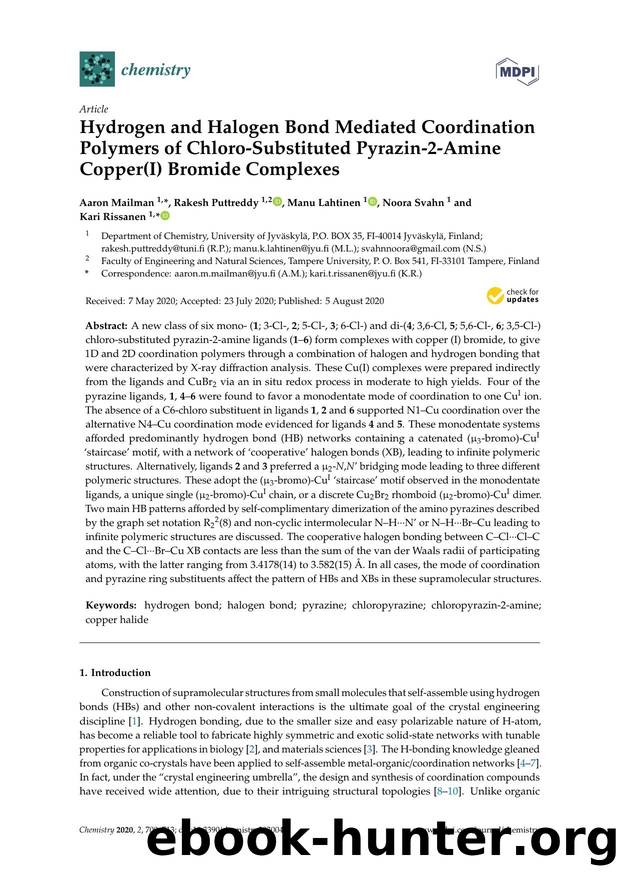Hydrogen and Halogen Bond Mediated Coordination Polymers of Chloro-Substituted Pyrazin-2-Amine Copper(I) Bromide Complexes by Aaron Mailman Rakesh Puttreddy Manu Lahtinen Noora Svahn & Kari Rissanen

Author:Aaron Mailman, Rakesh Puttreddy, Manu Lahtinen, Noora Svahn & Kari Rissanen
Format: pdf
Tags: A new class of six mono- (1; 3-Cl-, 2; 5-Cl-, 3; 6-Cl-) and di-(4; 3,6-Cl, 5; 5,6-Cl-, 6; 3,5-Cl-) chloro-substituted pyrazin-2-amine ligands (1–6) form complexes with copper (I) bromide, to give 1D and 2D coordination polymers through a combination of halogen and hydrogen bonding that were characterized by X-ray diffraction analysis. These Cu(I) complexes were prepared indirectly from the ligands and CuBr2 via an in situ redox process in moderate to high yields. Four of the pyrazine ligands, 1, 4–6 were found to favor a monodentate mode of coordination to one CuI ion. The absence of a C6-chloro substituent in ligands 1, 2 and 6 supported N1–Cu coordination over the alternative N4–Cu coordination mode evidenced for ligands 4 and 5. These monodentate systems afforded predominantly hydrogen bond (HB) networks containing a catenated (3-bromo)-CuI ‘staircase’ motif, with a network of ‘cooperative’ halogen bonds (XB), leading to infinite polymeric structures. Alternatively, ligands 2 and 3 preferred a 2-N,N’ bridging mode leading to three different polymeric structures. These adopt the (3-bromo)-CuI ‘staircase’ motif observed in the monodentate ligands, a unique single (2-bromo)-CuI chain, or a discrete Cu2Br2 rhomboid (2-bromo)-CuI dimer. Two main HB patterns afforded by self-complimentary dimerization of the amino pyrazines described by the graph set notation R22(8) and non-cyclic intermolecular N–HN’ or N–HBr–Cu leading to infinite polymeric structures are discussed. The cooperative halogen bonding between C–ClCl–C and the C–ClBr–Cu XB contacts are less than the sum of the van der Waals radii of participating atoms, with the latter ranging from 3.4178(14) to 3.582(15) Å. In all cases, the mode of coordination and pyrazine ring substituents affect the pattern of HBs and XBs in these supramolecular structures., hydrogen bond; halogen bond; pyrazine; chloropyrazine; chloropyrazin-2-amine; copper halide
Download
This site does not store any files on its server. We only index and link to content provided by other sites. Please contact the content providers to delete copyright contents if any and email us, we'll remove relevant links or contents immediately.
Whiskies Galore by Ian Buxton(41866)
Introduction to Aircraft Design (Cambridge Aerospace Series) by John P. Fielding(33064)
Small Unmanned Fixed-wing Aircraft Design by Andrew J. Keane Andras Sobester James P. Scanlan & András Sóbester & James P. Scanlan(32743)
Craft Beer for the Homebrewer by Michael Agnew(18140)
Turbulence by E. J. Noyes(7935)
The Complete Stick Figure Physics Tutorials by Allen Sarah(7307)
Kaplan MCAT General Chemistry Review by Kaplan(6866)
The Thirst by Nesbo Jo(6826)
Bad Blood by John Carreyrou(6543)
Modelling of Convective Heat and Mass Transfer in Rotating Flows by Igor V. Shevchuk(6391)
Learning SQL by Alan Beaulieu(6208)
Weapons of Math Destruction by Cathy O'Neil(6139)
Man-made Catastrophes and Risk Information Concealment by Dmitry Chernov & Didier Sornette(5921)
Digital Minimalism by Cal Newport;(5661)
Life 3.0: Being Human in the Age of Artificial Intelligence by Tegmark Max(5474)
iGen by Jean M. Twenge(5366)
Secrets of Antigravity Propulsion: Tesla, UFOs, and Classified Aerospace Technology by Ph.D. Paul A. Laviolette(5309)
Design of Trajectory Optimization Approach for Space Maneuver Vehicle Skip Entry Problems by Runqi Chai & Al Savvaris & Antonios Tsourdos & Senchun Chai(5011)
Electronic Devices & Circuits by Jacob Millman & Christos C. Halkias(4907)
